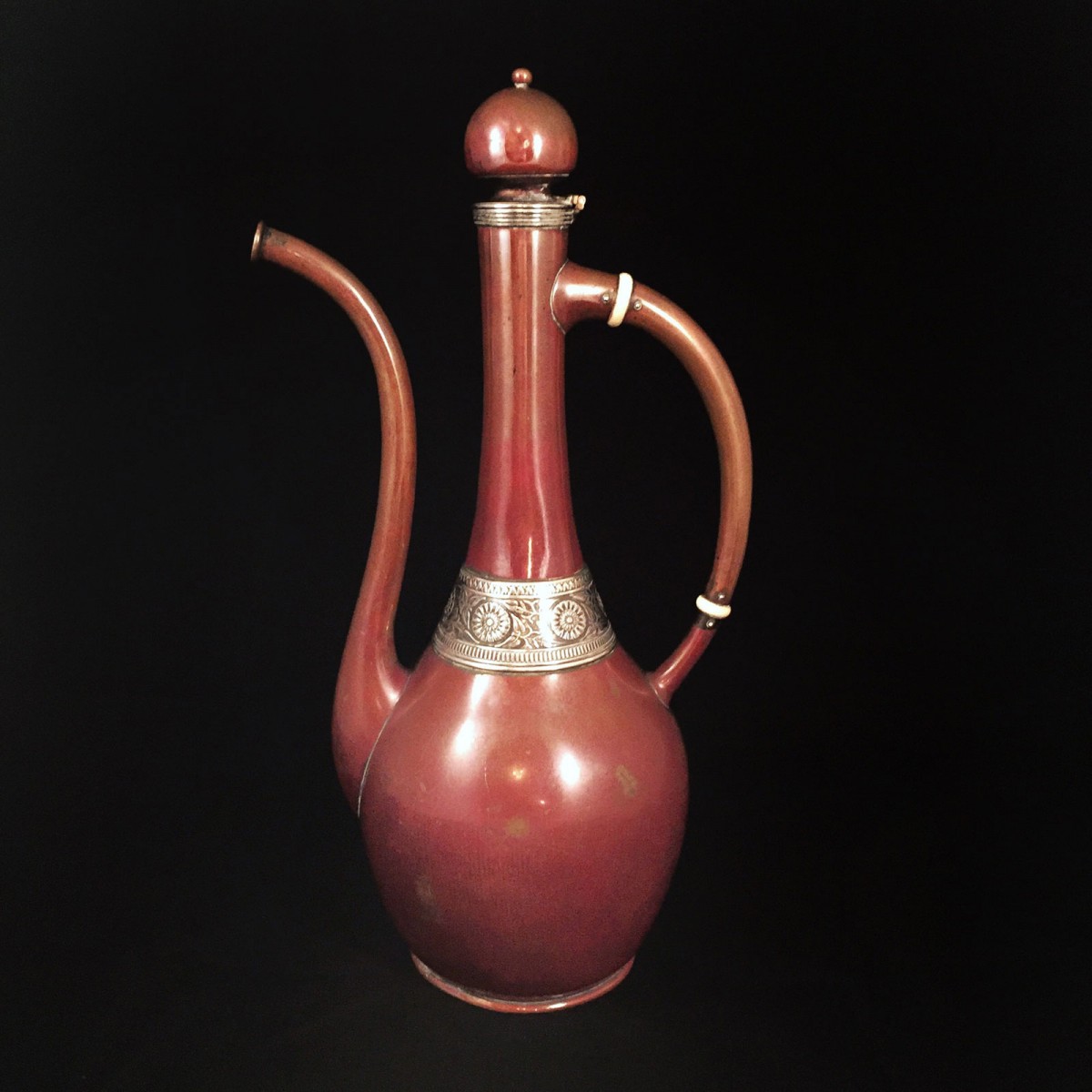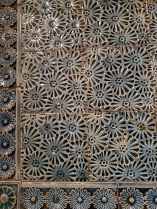The World in the Nickersons' House: Gorham Manufacturing Company Coffee Pot
October 20, 2021
Coffee Pot, Gorham Manufacturing Company, 188`. Collection of the Richard H. Driehaus Museum
[Grace Sophia Law, a volunteer at the Museum in Summer, 2021, contributed this essay to the blog. She is an Anthropology major with a Spanish and Museum Studies minor and will be graduating from Beloit College in 2022.]
This matched set of ‘Turkish’ coffeepots, located in the Sitting Room, are not from Turkey. They were made by the Gorham Manufacturing Company of Providence, Rhode Island in 1881 in the Arabesque style. 1 With smooth curves, a wine-red patina, and mixed-metal ornamentation that could be customized by the buyer, our set has a collar of flower and foliate designs around the neck of the pot.


There exist in private collections several similar pieces from the same time that could be formed into a set with this one, including a teapot, sugar bowl, and brazier for keeping the teapot warm. 2 In these comparable objects, we see a glimpse of the range of customizable motifs on offer.

Naturalism-inspired details were typical of Gorham, which liked lighter, more rustic variations on heavy ornamental Victorian wares - a trend that anticipated the Art Nouveau period in the early 20th century. 3 Later objects using the same mold from this period also include exoticized natural motifs, such as cherry blossoms and lotus pads. 4 Many of the tea and coffee sets from this period and later have Chinese and Japanese influences as well as Arab ones; no matter the company that made them, combining these elements indiscriminately was a sensation in home décor during the 50 years around the turn of the last century. 5
Invoking exotic places with one’s taste was a sign of being well-travelled, 6 and the matching Arabesque stylings of the Sitting Room were meant to reflect the power and beauty of the medieval Arab world. 7

The Middle Eastern influences project the fetishized idea of decadence and sensuality common in European depictions of the East, and thus a relaxed separation from the modest and restrained ideal of late 19th century America. 8 Mrs. Nickerson would have used this private sitting room connected to her bedroom, known as her boudoir by upper-class people, to entertain intimate friends and family. 9 In this room, and at these events, women were a little bit freer to discard the formalities of their lives. These events could run the gamut from entirely informal to intricate performances of etiquette, the most integral and commonplace of which was the serving of tea and coffee.
By the late 19th century, tea and coffee and their precious caffeine were well-established across the world, fueling the mornings of workers and industrialists alike. 10 As dinner was served very late for the wealthy, often nearing nine or ten o’clock, afternoon tea at five 11 was a necessary pick-me-up that also provided an opportunity for women who could afford to do so to get together and relax. The invitation of men was entirely based on whether they’d have a good time, with noticeable tirades against the practice as unmanly in the press. 12 New tea gowns were created for the purpose of tea parties, especially sex-segregated ones. Made of velvets and brocades and meant to be worn without corsets, they combined elements of the pleated sack-back gown of the late 18th century with the beginnings of the loose, pigeon-breasted “lingerie dress” to come at the turn of the 20th – truly a luxury that would have been seen as improper only 50 years earlier. 13

Every drink had its own special serving ware and appropriate accompaniments, and it was up to the lady of the house, such as Mrs. Nickerson, to be well-versed in this etiquette. Tea, coffee, and chocolate would be enjoyed throughout, with sweet and savory dishes. 14 Alcohol was considered inappropriate. Common menu items included finger sandwiches, tartlets, jellies, ice cream, sponge cakes, and other light foods that were laborious to make and delicately served. 15 Afternoon tea was a weekly or daily respite for those who had friends who could afford it, away from household demands, husbands, and the social plagues of their lives. 16 Through the performance of consumerism, worldliness, and knowledge inherent in the etiquette and curation of the menu, the hostess and guests could put on airs of relaxation while comfortably assured in their social positions, often as several servants helped to attend to guests. 17
When we look upon the decorative objects at the Driehaus Museum, we may appreciate their aesthetic beauty and view them entirely as art pieces on their own. But objects made to be used, such as these coffee pots, have social lives in how they are used, appreciated, and loved. The craftsmanship of these coffee pots may be appreciated by us as art, but no matter how extravagant the piece, we cannot fully understand them-- or the people who used them-- without understanding the context of their use. The true artistry of the 19th century tea party is not in the objects themselves, but in how they came together to influence attitudes about a rapidly-globalizing world and the ideas that came with it.
1 The British Museum. Object: coffee-pot, accessioned 1989. British Museum Digital Collections. Updated 2020. Accessed 21 August 2021. https://www.britishmuseum.org/collection/object/H_1989-0703-1
2 Nelson and Nelson Antiques. “Mixed Metal Aesthetic Japonesque Teapot on Stand”. Updated 2019, Accessed 21 August 2021.
3 McGoey, Elizabeth. 2017. American Silver in the Art Institute of Chicago. Yale University Press. 172-175, 204.
4 Coffee pot, circa 1890. Copper, silver, and ivory, 12 15/16” x 7 x 5 1/8 inches. As seen in “The Glories of Gorham” in The Magazine Antiques.
5 Anderson, Anne, “Fearful Consequences…of Living Up to One’s Teapot: Men, Women and “Cultchah” of the English Aesthetic Movement, 1870-1900”. In Victorian Literature and Culture 37 (1).
6 Hsai, Paul F. 1997. “Chinoiserie in 18th Century England”. American Journal of Chinese Studies 4, No 2. 238-51.
7 Said, Edward. 1978. Orientalism Chapter 1 – “Knowing the Oriental”. Routeledge Press, London, UK.
8 Ibid.
9 Boudoir – Collins English Dictionary. Retrieved 21 August 2021.
10 Hsai, Paul F. 1997. “Chinoiserie in 18th Century England”. American Journal of Chinese Studies 4, No 2. 238-51.
11 Ladies’ Home Journal and Practical Housekeeper, Volumes 5-6. Philadelphia: Curtis Publishing, Co., 1887.
12 Ibid.
13 Logan, Mrs. John A. The Home Manual: Everybody’s Guide in Social, Domestic, and Business Life. Boston: A. M. Thayer & Co., 1889.
14 Table Talk, Vol. X. Philadelphia: Arthur H. Christ Co., 1895.
15 Ibid.
16 Ladies’ Home Journal and Practical Housekeeper, Volumes 5-6. Philadelphia: Curtis Publishing, Co., 1887
17 Ibid.